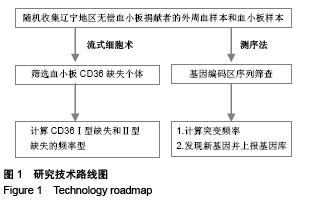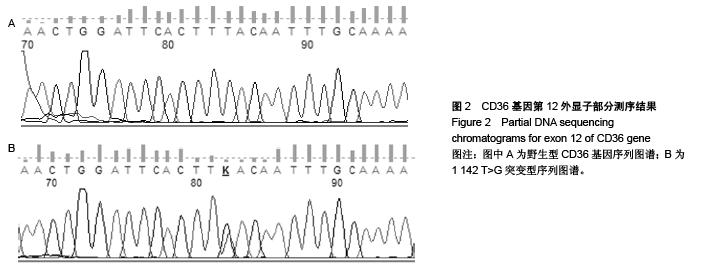| [1] Love-Gregory L, Sherva R, Schappe T, et al. Common CD36 SNPs reduce protein expression and may contribute to a protective atherogenic profile. Hum Mol Genet. 2011;20(1): 193-201.[2] Brouwers A, Langlois M, Delanghe J, et al. Oxidized low-density lipoprotein, iron stores, and haptoglobin polymorphism. Atherosclerosis. 2004;176(1):189-195.[3] Yamamoto N, Akamatsu N, Sakuraba H, et al. Platelet glycoprotein IV (CD36) deficiency is associated with the absence (type I) or the presence (type II) of glycoprotein IV on monocytes. Blood. 1994;83(2):392-397.[4] Lee K, Godeau B, Fromont P, et al. CD36 deficiency is frequent and can cause platelet immunization in Africans. Transfusion. 1999;39(8):873-879.[5] Culler EE, Hillyer CD, Haight AE, et al. CD36 immunization in a patient undergoing hematopoietic stem cell transplantation. Pediatr Blood Cancer. 2008;50(3):660-662.[6] Yin XL, Shen WD, Chen YS, et al. Refractory platelet transfusion in a patient with CD36 deficiency due to pseudothrombocytopenia. Platelets. 2011;22(3):237-240.[7] Tomiyama Y, Take H, Ikeda H, et al. Identification of the platelet-specific alloantigen, Naka, on platelet membrane glycoprotein IV. Blood. 1990;75(3):684-687.[8] Taketani T, Ito K, Mishima S, et al. Neonatal isoimmune thrombocytopenia caused by type I CD36 deficiency having novel splicing isoforms of the CD36 gene. Eur J Haematol. 2008;81(1):70-74.[9] 丁浩强,叶欣,王嘉励,等.应用PCR-SBT方法检测Cd36相关基因变异的研究[J].中华微生物学和免疫学杂志,2011,31(8):760- 762.[10] Curtis BR, Aster RH. Incidence of the Nak(a)-negative platelet phenotype in African Americans is similar to that of Asians. Transfusion. 1996;36(4):331-334.[11] Fry AE, Ghansa A, Small KS, et al. Positive selection of a CD36 nonsense variant in sub-Saharan Africa, but no association with severe malaria phenotypes. Hum Mol Genet. 2009;18(14):2683-2692.[12] Tanaka T, Nakata T, Oka T, et al. Defect in human myocardial long-chain fatty acid uptake is caused by FAT/CD36 mutations. J Lipid Res. 200142(5):751-759.[13] Kashiwagi H, Tomiyama Y, Kosugi S, et al. Identification of molecular defects in a subject with type I CD36 deficiency. Blood. 1994;83(12):3545-3552.[14] Xu X, Liu Y, Hong X, et al. Variants of CD36 gene and their association with CD36 protein expression in platelets. Blood Transfus. 2014;12(4):557-564.[15] Li R, Qiao Z, Ling B, et al. Incidence and molecular basis of CD36 deficiency in Shanghai population.Transfusion. 2015; 55(3):666-673.[16] Andersen M, Lenhard B, Whatling C, et al. Alternative promoter usage of the membrane glycoprotein CD36. BMC Mol Biol. 2006;7:8.[17] Sato O, Takanashi N, Motojima K.Third promoter and differential regulation of mouse and human fatty acid translocase/CD36 genes. Mol Cell Biochem. 2007;299(1-2):37-43.[18] Feng J, Han J, Pearce SF, et al. Induction of CD36 expression by oxidized LDL and IL-4 by a common signaling pathway dependent on protein kinase C and PPAR-gamma.J Lipid Res. 2000;41(5):688-696.[19] Griffin E, Re A, Hamel N, et al. A link between diabetes and atherosclerosis: Glucose regulates expression of CD36 at the level of translation. Nat Med. 2001;7(7):840-846.[20] Liang CP, Han S, Okamoto H, et al. Increased CD36 protein as a response to defective insulin signaling in macrophages.J Clin Invest. 2004;113(5):764-773.[21] Yesner LM, Huh HY, Pearce SF, et al. Regulation of monocyte CD36 and thrombospondin-1 expression by soluble mediators. Arterioscler Thromb Vasc Biol. 1996;16(8): 1019-1025.[22] Yanai H, Chiba H, Morimoto M, et al. Human CD36 deficiency is associated with elevation in low-density lipoprotein- cholesterol. Am J Med Genet. 2000;93(4):299-304.[23] 王嘉励,叶欣,丁浩强,等.广州地区无偿献血者CD36基因突变的频率调查[J].中国免疫学杂志,2011,27(8):718-720.[24] Kashiwagi H, Tomiyama Y, Nozaki S, et al. Analyses of genetic abnormalities in type I CD36 deficiency in Japan: identification and cell biological characterization of two novel mutations that cause CD36 deficiency in man. Hum Genet. 2001;108(6):459-466.[25] König H, Pfisterer P, Corcoran LM, et al. Identification of CD36 as the first gene dependent on the B-cell differentiation factor Oct-2. Genes Dev. 1995;9(13):1598-1607.[26] Omi K, Ohashi J, Patarapotikul J, et al. CD36 polymorphism is associated with protection from cerebral malaria. Am J Hum Genet. 2003;72(2):364-374.[27] Kashiwagi H, Tomiyama Y, Nozaki S, et al. A single nucleotide insertion in codon 317 of the CD36 gene leads to CD36 deficiency. Arterioscler Thromb Vasc Biol. 1996;16:1026- 1032.[28] Hsu LA, Ko YL, Wu S, et al. Association between a novel 11-base pair deletion mutation in the promoter region of the scavenger receptor class B type I gene and plasma HDL cholesterol levels in Taiwanese Chinese.Arterioscler Thromb Vasc Biol. 2003;23(10):1869-1874.[29] Yanai H, Chiba H, Fujiwara H, et al. Phenotype-genotype correlation in CD36 deficiency types I and II. Thromb Haemost. 2000;84(3):436-441.[30] Kashiwagi H, Tomiyama Y, Kosugi S, et al. Family studies of type II CD36 deficient subjects: linkage of a CD36 allele to a platelet-specific mRNA expression defect(s) causing type II CD36 deficiency. Thromb Haemost. 1995;74(2):758-763.[31] Imai M, Tanaka T, Kintaka T, et al. Genomic heterogeneity of type II CD36 deficiency. Clin Chim Acta. 2002;321(1-2): 97-106.[32] Ra? ME, Safranow K, Poncyljusz W. Molecular basis of human CD36 gene mutations. Mol Med. 2007;13(5-6): 288-296.[33] Hanawa H, Watanabe K, Nakamura T, et al. Identification of cryptic splice site, exon skipping, and novel point mutations in type I CD36 deficiency. J Med Genet. 2002;39(4):286-291. |


.jpg)
.jpg)
.jpg)